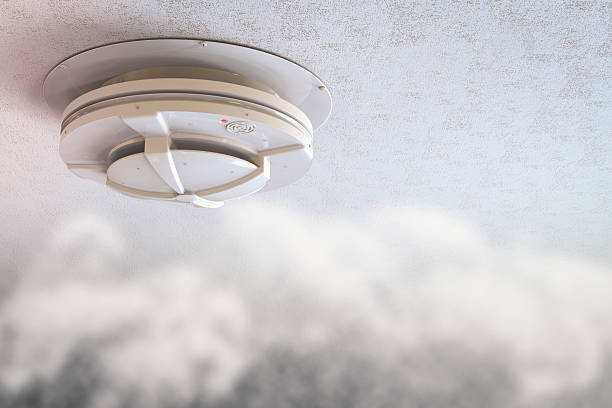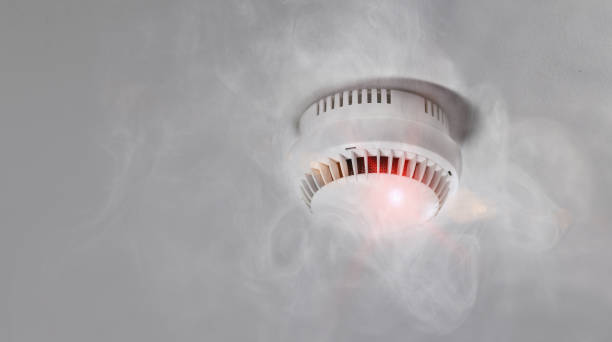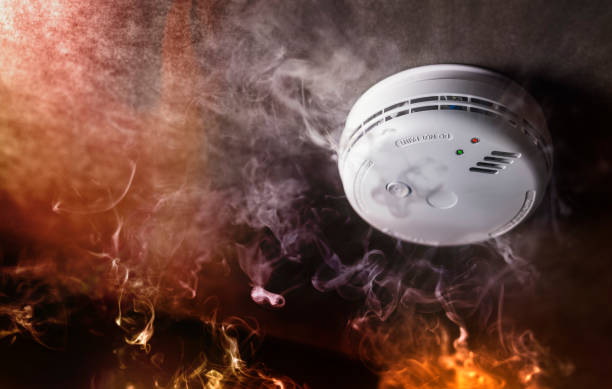Tired of that annoying chirp waking you up at 3 AM? Our comprehensive guide will help you silence your smoke detector and restore peace to your home while keeping your family safe.
Last Updated: April 7, 2025 | Reading Time: 15 minutes
Quick Fix Guide: Stop That Beeping Now!
Need immediate silence? Here’s what to do:
- Replace the battery with a fresh one (usually 9V)
- Hold the test button for 15-20 seconds to reset
- Clean dust from detector vents with compressed air
- Check manufacturing date – replace if older than 10 years
Jump to detailed sections:
- Understanding Beeping Causes
- Common Beeping Causes
- Beeping Pattern Guide
- Step-by-Step Solutions
- Replacement Guide
- Prevention Tips
- FAQ
Understanding Why Your Smoke Detector Won’t Stop Beeping
Few household sounds are as persistently annoying as a chirping smoke detector, especially when it decides to start in the middle of the night. That intermittent beep every 30-60 seconds isn’t just designed to be irritating – it’s intentionally frustrating to ensure you take action.
Smoke detectors are critical safety devices that save countless lives each year, but when they malfunction or need maintenance, they certainly know how to get your attention. The good news? Most beeping issues can be resolved quickly once you understand what’s causing them.

Common Causes of Smoke Detector Beeping
Before diving into solutions, it’s helpful to understand why your smoke detector is making that annoying chirp in the first place. By identifying the cause, you can apply the right fix and prevent future occurrences.
1. Battery-Related Issues
The most common culprit behind smoke detector beeping is battery problems:
- Low battery power: When batteries reach approximately 20% remaining capacity, most detectors will start chirping to alert you it’s time for replacement
- Improperly installed batteries: Batteries not seated correctly or with reversed polarity can trigger warning beeps
- Battery drawer not fully closed: Even slightly open battery compartments can cause intermittent beeping
- Incorrect battery type: Using the wrong battery type or voltage can create compatibility issues
- Corroded battery terminals: Corrosion can prevent proper electrical contact
Even hardwired smoke detectors have backup batteries that can cause beeping when they’re running low. This surprises many homeowners who assume their wired detectors don’t need battery maintenance.
2. End-of-Life Warnings
Smoke detectors don’t last forever:
- Age-related expiration: Most smoke detectors are designed to function reliably for 8-10 years before requiring replacement
- End-of-life notification: Many modern detectors will chirp differently when reaching end-of-life (often three beeps instead of one)
- Manufacturing date: Check the manufacturing date printed on the back of your unit; detectors older than 10 years should be replaced regardless of apparent function
3. Environmental Factors
Your home environment can trigger false alarms or warning beeps:
- Humidity and steam: Bathrooms and kitchens can expose detectors to moisture that triggers malfunction warnings
- Dust and debris: Accumulated dust in the sensing chamber can interfere with proper operation
- Temperature fluctuations: Operations outside the recommended range (typically 40-95°F) can cause beeping
- Air flow issues: Ceiling fans, heating vents, or drafty windows near detectors can cause false readings
- Insect infiltration: Small insects can enter the sensing chamber and trigger alarms or malfunction warnings
4. System and Wiring Problems
For hardwired smoke detector systems:
- Power surges: Electrical spikes can reset detectors or trigger error states
- Loose wiring connections: Poor electrical connections in hardwired systems can cause inconsistent power delivery
- System resets: Power outages or electrical work can put hardwired detectors into reset or error mode
- Interconnection issues: In interconnected systems, problems with one detector can trigger beeping in all units
How to Decipher Different Beeping Patterns
Not all beeps are created equal. Paying attention to the specific pattern can help identify the issue:
| Beeping Pattern | Likely Meaning | Recommended Action |
|---|---|---|
| Single chirp every 30-60 seconds | Low battery warning | Replace battery |
| Three chirps every 30-60 seconds | End-of-life warning | Replace detector |
| Five rapid chirps | End-of-life or sensor failure | Replace detector |
| Continuous, rapid beeping | Active smoke or fire detection | Check for fire, evacuate if necessary |
| Alternating patterns | CO detection (for combination alarms) | Ventilate area, check for CO source |
Manufacturer patterns may vary, so consulting your detector’s manual for specific beep codes is always recommended. Visit our alarm issues and solutions page for model-specific beep pattern guides.
Step-by-Step Solutions to Stop Smoke Detector Beeping
Now that we understand the potential causes, let’s explore how to silence that annoying beep once and for all.
1. Replace the Battery
The simplest and most common solution is replacing the battery:
For Battery-Powered Detectors:
- Carefully remove the detector from its mounting bracket (usually twists off counterclockwise)
- Open the battery compartment
- Remove the old battery
- Insert a fresh battery, ensuring correct polarity alignment
- Close the battery compartment securely
- Remount the detector to its bracket
- Test the alarm using the test button
For Hardwired Detectors:
- Switch off power at the circuit breaker
- Remove the detector from its mounting bracket
- Disconnect the power connector
- Replace the backup battery
- Reconnect the power
- Remount the detector
- Restore power at the circuit breaker
- Test the alarm function
Pro Tips for Battery Replacement:
- Use high-quality alkaline batteries with expiration dates at least 4-5 years in the future
- Consider using lithium batteries for longer life in hard-to-reach detectors
- Never mix old and new batteries in the same device
- Mark replacement date on the inside of the detector with a permanent marker
- Replace all smoke detector batteries simultaneously to maintain a regular schedule
2. Reset Your Smoke Detector
Sometimes, even with a new battery, the detector continues beeping. This often happens because the internal processor is holding an error state. Try a complete reset:
- Remove the detector from its mounting bracket
- Disconnect the power source (battery or hardwired connection)
- Press and hold the test button for at least 15-20 seconds
- Release the button and wait 1 minute
- Reinstall the battery or reconnect power
- Remount the detector
This process forces the detector to clear its internal memory and restart fresh, often resolving stubborn beeping issues.
3. Clean Your Smoke Detector
Dust and debris accumulation can trigger false alarms and error states:
- Gently vacuum the exterior vents using a soft brush attachment
- Use compressed air to blow out any remaining dust
- For persistent issues, consider using the manufacturer’s recommended cleaning method
Important: Never use cleaning chemicals on smoke detectors as they can damage sensitive components or trigger false alarms.
4. Address Environmental Factors
If environmental conditions are causing beeping:
- Relocate the detector if it’s near bathrooms, kitchens, or heating/cooling vents
- Maintain proper humidity levels in your home (ideally 30-50%)
- Check for drafts that might be bringing dust or temperature fluctuations
- Ensure proper clearance around the detector (typically 12 inches from walls for ceiling-mounted units)
5. Check for End-of-Life Indicators
If your smoke detector is approaching or past 10 years old:
- Check the manufacturing date printed on the back of the unit
- If it’s older than 8-10 years, replace the entire detector regardless of other troubleshooting steps
- Ensure the replacement meets current safety standards
Smoke Detector Brand Comparison: Reset Procedures
Different brands have different reset methods. Use this quick reference:
| Brand | Standard Reset Procedure | Special Notes |
|---|---|---|
| First Alert | Hold test button 15-20 seconds | Different models may have different reset sequences |
| Kidde | Remove battery, hold test button 15 seconds | Some models require 3 consecutive button presses |
| Nest Protect | Use app for reset, or press button until light ring turns blue | Requires functioning WiFi for full reset |
| BRK | Hold test button 20 seconds, until alarm sounds | Power must be removed first |
| Honeywell | Remove from bracket, disconnect power, hold test button 5 seconds | Wait 2 minutes before restoring power |
For model-specific reset instructions, visit our comprehensive reset guide.
When to Replace Your Smoke Detector

While troubleshooting can resolve many beeping issues, sometimes replacement is the only viable solution:
- Detectors over 10 years old
- Units with visible damage or discoloration
- Detectors that fail routine testing
- Models that continue beeping despite troubleshooting
- Outdated technology lacking modern safety features
When replacing, consider upgrading to newer technologies like photoelectric sensors or combination smoke/CO detectors for enhanced protection.
Recommended Smoke Detector Models (2025)
Looking for a reliable replacement? Here are top-rated options:
- For standard protection: First Alert SA511CN2-3ST or Kidde RF-SM-DC
- For smart home integration: Google Nest Protect or Ring Alarm Smoke and CO Listener
- For budget-conscious buyers: Kidde i9050 or First Alert SA320CN
- For extended battery life: First Alert PR710 (10-year battery)
- For hearing impaired: Kidde P4010ACLEDSCOCA with strobe light alerts
Specialized Solutions for Different Detector Types
Different types of smoke detectors may require slightly different approaches:
Photoelectric Smoke Detectors
These detectors use light sensors to detect smoke particles:
- More sensitive to dusty environments
- May require more frequent cleaning
- Often feature accessible sensing chambers for maintenance
Ionization Smoke Detectors
These use radioactive material to detect smoke:
- Cannot be cleaned internally
- More prone to nuisance alarms from cooking or shower steam
- May have shorter overall lifespans
Combination Smoke/CO Detectors
These detect both smoke and carbon monoxide:
- Often have different beeping patterns for different alerts
- May require specific reset procedures
- Typically have shorter lifespans (5-7 years rather than 10)
Smart Smoke Detectors
Modern smart detectors like Nest Protect or First Alert Onelink:
- May send smartphone notifications instead of or in addition to beeping
- Often have self-diagnostic capabilities
- Can be silenced through apps in some cases
- May require Wi-Fi connection troubleshooting
Preventing Future Beeping Episodes
Proactive maintenance can prevent those middle-of-the-night chirping episodes:
- Mark your calendar for regular battery replacements (typically every 6 months)
- Test detectors monthly using the test button
- Vacuum detectors quarterly to prevent dust buildup
- Document installation dates and schedule replacements at appropriate intervals
- Maintain consistent home temperature when possible
- Keep spare batteries in an easily accessible location
Many people change batteries during daylight saving time changes as an easy-to-remember schedule.
Smoke Detector Location Requirements
Proper placement is crucial for both function and preventing false alarms:
| Area | Placement Requirements | Special Considerations |
|---|---|---|
| Bedrooms | One inside each bedroom | Place on ceiling or high on wall |
| Kitchen | At least 10 feet from cooking appliances | Consider heat/smoke detectors specially designed for kitchens |
| Hallways | Outside sleeping areas | Central location for best coverage |
| Living Areas | One per level of home | Away from windows, doors, and vents |
| Basement | Near stairs and on ceiling | Not near furnaces or water heaters |
| Attic | If finished space | Temperature-rated models only |
For state-specific requirements, check with your local fire department or visit the NFPA website.
Common Questions About Beeping Smoke Detectors
Why does my smoke detector chirp more at night?
This common phenomenon occurs because:
- Home temperatures typically drop at night
- Lower temperatures reduce battery output
- When battery voltage falls below threshold, beeping begins
- With morning temperature increases, voltage may temporarily recover
This explains why a detector might chirp all night but remain silent during daylight hours.
Can I just remove the battery to stop the beeping?
While removing the battery will stop the beeping, it leaves your home without crucial fire protection. According to the National Fire Protection Association (NFPA), homes without working smoke alarms experience twice as many fire fatalities. Always replace batteries rather than removing them.
Why does my hardwired smoke detector beep during power outages?
Hardwired systems switch to backup battery power during outages. If the backup battery is low, the detector will chirp to alert you. This is a critical safety feature ensuring continuous protection even during electrical interruptions.
How do I stop interconnected smoke detectors from all beeping?
In interconnected systems:
- Identify the initiating detector (usually the one with a flashing light)
- Address issues with that specific unit first
- Reset the entire system according to manufacturer instructions
- Replace batteries in all units if the problem persists
How can I silence a smoke detector temporarily?
Most detectors have a silence/hush button that temporarily disables alarms for 5-10 minutes. This is useful for false alarms while cooking. To use this feature:
- Press the silence button (usually labeled “Hush” or “Silence”)
- The detector may continue to chirp or flash to indicate it’s in silence mode
- The detector will automatically reactivate after the silence period
Never use the silence feature during a real fire emergency.
Special Considerations for Different Living Situations
Renters
If you rent your home:
- Notify your landlord about malfunctioning detectors
- Be aware that landlords are legally required to maintain working smoke detectors
- Document all communication regarding detector issues
- Check local rental laws regarding smoke detector maintenance responsibilities
High Ceilings
For homes with high or vaulted ceilings:
- Consider detectors with remote testing/silencing capabilities
- Use extension poles designed for smoke detector maintenance
- Schedule professional maintenance if heights pose safety risks
- Choose long-life battery options to reduce maintenance frequency
Commercial Buildings
Commercial properties have different requirements:
- Follow building code requirements for testing and maintenance
- Maintain proper documentation of all detector service
- Consider professional servicing for liability protection
- Ensure compliance with ADA and other regulatory requirements
Local Fire Department Resources
Many local fire departments offer smoke detector assistance:
- Free smoke detector installation programs
- Battery replacement assistance for elderly or disabled residents
- Home fire safety inspections
- Educational resources about detector maintenance
Contact your local fire department’s non-emergency number to inquire about programs in your area.
Choosing the Right Replacement Detector
When it’s time for replacement, consider these factors:
- Detection technology: Photoelectric (better for smoldering fires) vs. ionization (better for flaming fires) vs. dual-sensor
- Power source: Battery-only vs. hardwired with battery backup
- Smart features: App connectivity, remote silencing, self-testing capabilities
- Interconnection: Ability to communicate with other detectors
- Voice alerts: Spoken warnings instead of just beeping
- CO detection: Combined smoke and carbon monoxide protection
- Lifespan: Longer warranties often indicate better quality
Recommended Accessories
These accessories can make smoke detector maintenance easier:
- Battery testers
- Detector cleaning kits
- Extension poles for high ceilings
- Mounting brackets for special applications
- Protective covers for high-dust environments
The Importance of Working Smoke Detectors
While beeping smoke detectors can be annoying, they play a crucial role in home safety:
- Working smoke detectors cut the risk of dying in a home fire by approximately 55% according to the American Red Cross
- You may have as little as two minutes to escape a home fire once an alarm sounds
- Most fatal fires occur when people are sleeping
- The peak time for home fire fatalities is between 11 PM and 7 AM when people are most likely to ignore or disable annoying detectors
This makes proper maintenance not just a matter of eliminating an annoying noise, but a critical safety practice.
Fire Safety Statistics You Should Know
Recent data highlights the importance of working smoke detectors:
- According to the U.S. Fire Administration, three out of five home fire deaths occur in properties without working smoke alarms
- The death rate is twice as high in homes without working smoke detectors compared to homes with working ones
- Approximately 2,500 people die in home fires each year in the United States
- Properly maintained smoke detectors reduce the risk of fire injury by 50%
Final Thoughts: Silence with Safety
While that midnight chirping can test anyone’s patience, remember that your smoke detector is just doing its job – alerting you to a situation that needs attention. By understanding why detectors beep and knowing how to address the root causes, you can restore silence to your home while maintaining the life-saving protection these devices provide.
For more detailed information about specific smoke detector models or more complex troubleshooting, visit our alarm issues and solutions page. You can also find additional resources about smoke detector maintenance and home fire safety at smokedetectorbeeping.com.
Need more comprehensive home safety information? The National Fire Protection Association provides excellent resources on fire safety and prevention that complement the information in this guide.
Remember: A properly functioning smoke detector is your first line of defense against the devastating effects of house fires. The few minutes it takes to maintain these devices could literally save your life.


发表回复